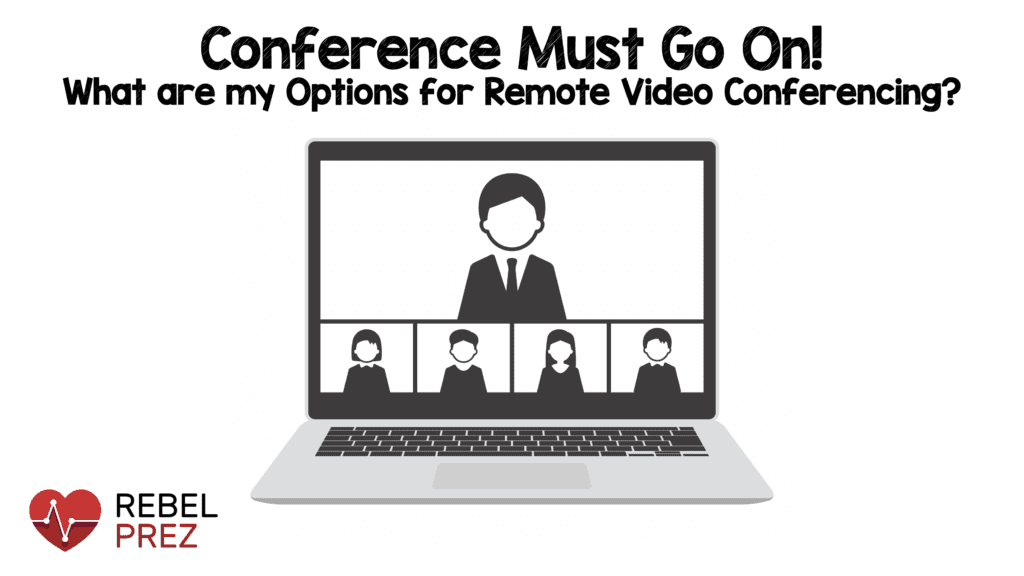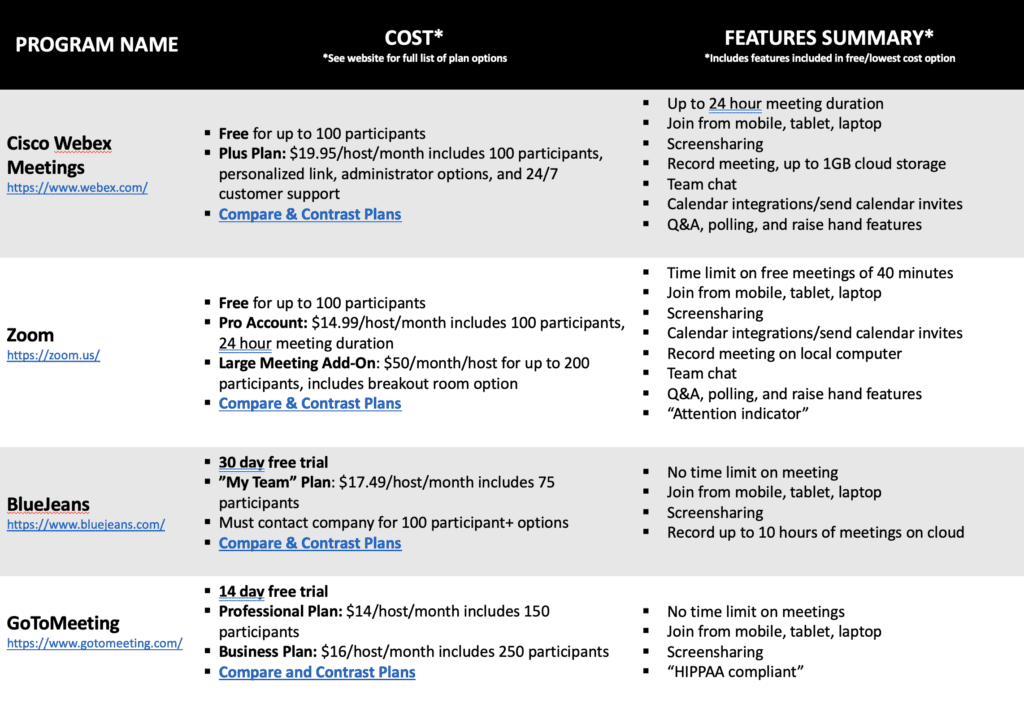
 In light of COVID19, many medical institutions are cancelling not only international and domestic travel, but any gatherings of greater than 20 people. This is leaving residency program leadership across the country scrambling to look for remote video conferencing options to deliver online didactic education. In this article, we will review some of the options that you might consider to host such meetings, with a particular focus on suggestions for weekly resident conference.
In light of COVID19, many medical institutions are cancelling not only international and domestic travel, but any gatherings of greater than 20 people. This is leaving residency program leadership across the country scrambling to look for remote video conferencing options to deliver online didactic education. In this article, we will review some of the options that you might consider to host such meetings, with a particular focus on suggestions for weekly resident conference.
First and foremost, some larger institutions already have an enterprise account with a particular video conference company, therefore this may be something to check into with your I.T. department. If not, the next consideration is: how many people will be required to host and participate in your meeting? If your entire institution is looking for solutions to video conferencing, your hospital or medical school should contact the company directly to price out options so that many people can host meetings simultaneously (side note: these will likely be expensive).
If you fall into the category like the rest of us and simply want to host a meeting for around 100 participants, there are many viable options, and a few really good options. All have some similar basic features, including HD video and audio options, as well as screensharing (i.e. one person can share their screen so that others can follow along (This is very important when presenting a PowerPoint lecture).
See the summary table of options below with associated costs and features below:

For more options visit: The Best Video Conferencing Software for 2020
Other Tips for Remote Didactic Conference:
Designate a Remote Conference Champion: Not everyone feels comfortable setting up a remote video conference, therefore you may want to identify someone in your department who can help you to learn about or implement the remote conference. Your I.T. department may or may not be helpful in this regard depending on what they’re willing to support.
Engage Faculty to Create Lectures: This is not much different than creating a conference schedule. Reach out to residents and faculty within your program (or even educators at other institutions) to provide lecture material. You may consider having one instructor (i.e. the APD or PD in charge of conference) or your “remote conference champion” collect the PowerPoints in advance as a backup in case of any technical difficulty with screensharing. If you don’t already, consider having them upload their materials to a shared Google Drive or Dropbox account in advance as well, with folders organized by date.
Keep Residents Engaged: How are you going to ensure that your residents are 1) paying attention, 2) not falling asleep or doing other tasks during this lecture time?
- Require the use of a video camera during the session. I like this idea because it’s already included in the account features for most of the programs.
- Zoom also has a unique feature called “Attention Tracking” which will start a clock next to the participant’s name if they do not have Zoom in the main field of video during screensharing.
- Include discussion questions throughout or at the end of the lecture to gauge understanding (people can also “raise hands” and be called on with most programs). You may use chat for this as well.
- Include a Kahoot! game in screenshare mode and have participants play the game.
- Create “Breakout Rooms” (for an additional cost, of course). For example, for $50/month, Zoom allows you to upgrade to the “Large Meeting feature” which includes up to 200 participants and also breakout room feature. This is an excellent option if you want to conduct small group breakouts and are willing to pay for the upgrade.
Ensure you’re maximizing your Individualized Interactive Instruction (III) credit, or asynchronous learning, which the ACGME permits to be used for up to 20% of conference (up to one hour weekly). Perhaps the most popular is the Academic Life in Emergency Medicine (ALiEM) Approved Instructional Resources (AIR) series, but programs have adapted many different learning modalities to fit their requirements. As long as there is program director monitoring for participation, faculty oversight, an evaluation component (i.e. quiz), and feedback, you can meet the requirements.
Final Considerations:
- Send out links to participate in advance. Many programs have the option to send a calendar invite but consider also sending via e-mail, so everyone has the link readily available.
- Ask those who are not speaking to “Mute” their microphones. This will decrease the amount of background noise. Note that some programs also allow the host to “Mute All” in case someone is not paying attention and has a hot mic.
- Consider how you’ll collect speaker feedback from the conference. Mostly, this should not change, however if you do any paper form of feedback you might need to transition to an online survey you can send out after the fact.
- Have a backup in case of technical difficulties. There is no way that this will always run smoothly. Just like in regular conference, you’ll want to have a backup plan in case something isn’t working. The easiest thing to do would be to switch gears and do a later lecture in an earlier time slot. You may also switch to a discussion-based lecture and do more of a Q&A style lecture with your participants.
- HIPPA compliance. It is not recommended that you share any protected health information using video conferencing. However, depending on the program, there may be a HIPAA compliant security features you can opt in on. This typically entails speaking directly with the company and setting up a healthcare or specialized plan, therefore contact the company for more details.
Good Luck and Happy Remote Conferencing! Feel free to contact me at spdimeo@gmail.com for any questions or comments on the above.
Guest Post By:

Sara P. Dimeo, MD
Clinical Assistant Professor, MedEdTech Fellowship Director
Prisma Health-Upstate, university of South Carolina, Greenville
Greenville, SC
Twitter: @saraparamd
For More on This Topic Checkout:
- ALiEM: Announcing ALIEM Remote
- ALiEM: Making Remote Work “Work” for You and Your Organization
- ALiEM: Teaching in the Age of COVID-19 – Live From the Recording Studio
- ALiEM: Teaching in the Age of COVID-19 – Small Group Conversations
- ALiEM: Teaching in the Age of COVID-19 – Enhancing Discussion with Digital Asynchronous Chats
- ALiEM: Teaching in the Age of COVID-19 – Assessing Learners Remotely
- ALiEM: Teaching in the Age of COVID-19 – The Learning Management System
- ALiEM: Teaching in the Age of COVID-19 – The Wrap-Up
References:
- ACGME Program Requirements for Graduate Medical Education in Emergency Medicine. (2019, July 1). Retrieved March 12, 2020. [Link is Here]
- Estes M et al. Individualized Interactive Instruction: A Guide to Best Practices from the Council of Emergency Medicine Residency Directors. WJEM 2019. [Link is Here]
- Toohey SL et al. Ten Tips for Engaging the Millennial Learner and Moving an Emergency Medicine Residency Curriculum into the 21st Century. WJEM 2016. [Link is HERE]
Post Peer Reviewed By: Anand Swaminathan, MD (Twitter: @EMSwami) and Salim R. Rezaie, MD (Twitter: @srrezaie)
The post Conference Must Go On! What are my Options for Remote Video Conferencing? appeared first on REBEL EM - Emergency Medicine Blog.
